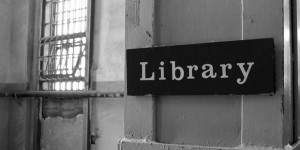Prison Libraries are a Positive Light
Public libraries have a huge mission, to provide information and intellectual access to their public. So this means that library access does not just extend towards patrons with access to the physical location of the library itself, but also to patrons who are unable to utilize the library in the freedom it has.
Prison libraries are a touchy subject to all key players in the conversation, be that the librarians, tax-payers, law makers, and prisons themselves. All of these previously mentioned characters in this story, in addition to those not mentioned, have their own stake in this discussion, each with an extremely valid argument as to why their stance on prison libraries is correct. Since this is a library-based blog, I am going to write in the context of why libraries are supportive of prison libraries, and how their services benefit the inmates both in the present, and future contexts. Below are some key points as to why prison libraries are helpful both the prisoners, but also their communities.
Background Facts
- In 2010, over 2.25 million American adults were incarcerated.
- With this above number being so staggeringly high, the American Library Association believes it is libraries across the nation's duty to "encourage public libraries and systems to extend their services to residents of jails and other detention facilities within their taxing areas."
- Providing library service to inmates and those returning from prison is fulfilling the democratic mission of the public library because it allows “a wholly segregated group of people” access to information that most Americans take for granted.
Rehabilitation Services
- The outstandingly high number of Americans incarcerated also suggests that there are a lot of current inmates, who are not sentenced to life-long jail terms, meaning that they expect to be released from jail in a relatively short amount of time.
- The use of prison libraries, therefore, can provide these inmates with opportunities to learn of opportunities available to them, via educational training, job resources, and simply, rehabilitation material they can utilize to ensure that they do not return to jail at a future time.
Libraries are Safe Zones
- A library is considered by most, if not all patrons as a safe zone. A prison library acts in the same way. Each inmate is treated with dignity and respect, and is not denied access to intellectual material, but rather, is encouraged to explore all avenues of the library.
- This stance the library holds takes the attitude of changing the prisoner's life in a positive way, because they are allowed to believe they are worth something, and empowered to start making a difference in their lives through library materials.
Reintegration and Outreach
- Studies show that 95% of inmates will return to their same community once they are released from prison. This means that these inmates will often be exposed to the same people, places, and things that landed them in jail in the first place.
- By having public libraries do outreach in cooperation with local prisons, this spark of communication could lead prisoners to their community library, rather than back into the slump of bad decisions.
- This concept of "reintegration" is crucial to prisoners becoming productive members of society, as well as having a further connection of services that local public libraries can provide.





No comments:
Post a Comment